Armpit rash can result from shaving (ingrown hair), irritant substances or allergic reactions (contact dermatitis), infections (ringworm, bacterial folliculitis, hidradenitis suppurativa), clogged sweat glands (heat rash), overactive sebaceous glands (seborrheic dermatitis) or diseases, such as diabetes or cancer (acanthosis nigricans). In another article, you can read about armpit lumps.
Treatment of the rash depends on the cause; it can include topical or oral antibiotics, antifungals, steroids and antihistamines.
Armpit rashes presented below:
1. Red bumps
2. Scaly patches
3. Dark rashes
4. Skin tags
1. Red Bumps
1.1. Ingrown Hair (Razor Bumps)
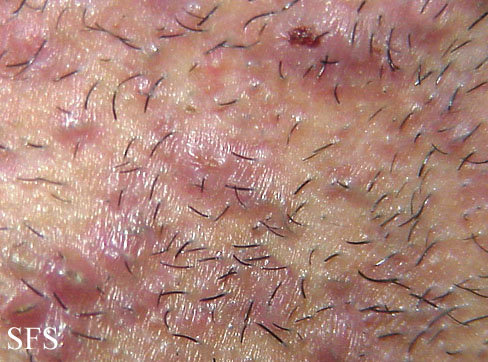 Ingrown hair can develop after waxing, pilling or shaving the armpits, especially in people with curly hair. It appears as itchy and tender red bumps with hair arising from them [9].
Ingrown hair can develop after waxing, pilling or shaving the armpits, especially in people with curly hair. It appears as itchy and tender red bumps with hair arising from them [9].
Prevention and treatment. Avoid shaving close to the skin and unnecessary epilation of the armpits. The rash can disappear on its own within several weeks [9]. A steroid cream containing hydrocortisone, and phototherapy can reduce itching [9].
Picture 1. Ingrown hair (source: Samuel Freire da Silva, MD, Dermatology Atlas)
1.2. Bacterial Folliculitis
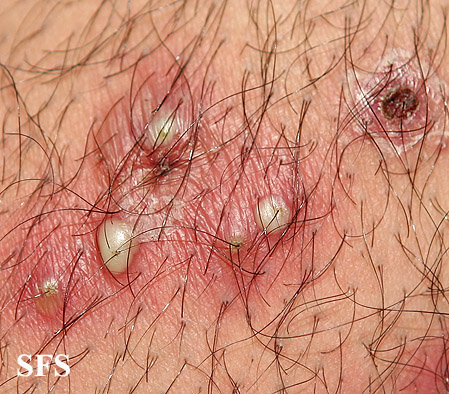 Bacterial folliculitis is an infection of the hair follicles, usually by the bacterium Staphylococcus aureus. It appears as multiple itchy or burning red acne-like pimples with white pus-filled centers [1]. It can result from bad hygiene, sharing the gym equipment, the friction of tight clothes or frequent shaving of the armpits.
Bacterial folliculitis is an infection of the hair follicles, usually by the bacterium Staphylococcus aureus. It appears as multiple itchy or burning red acne-like pimples with white pus-filled centers [1]. It can result from bad hygiene, sharing the gym equipment, the friction of tight clothes or frequent shaving of the armpits.
Treatment is with an ointment containing the antibiotic erythromycin or mupirocin [19].
Picture 2. Bacterial folliculitis (source: Samuel Freire da Silva, MD, Dermatology Atlas).
1.3. Heat Rash
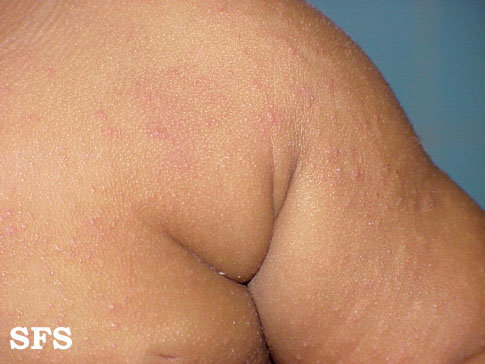 Heat rash (sweat rash, prickly heat, miliaria) appears as small translucent itchy or burning blisters, red, shallow bumps (papules) or deep lumps [7]. It is triggered by sweating. It can heal on its own in several weeks [7].
Heat rash (sweat rash, prickly heat, miliaria) appears as small translucent itchy or burning blisters, red, shallow bumps (papules) or deep lumps [7]. It is triggered by sweating. It can heal on its own in several weeks [7].
Treatment is by avoiding sweating and skin irritation, by calamine lotion or steroid creams [16].
Picture 3. Sweat rash or miliaria (source: Samuel Freire da Silva, MD, Dermatology Atlas)
1.4. Hidradenitis Suppurativa
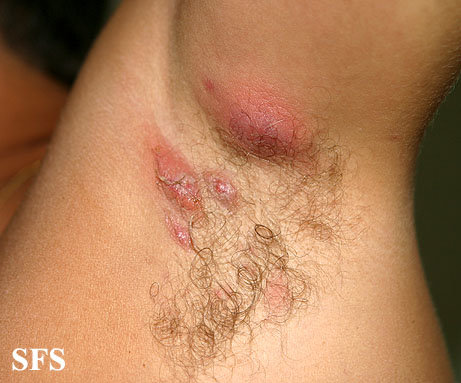 Hidradenitis suppurativa is a chronic inflammation of the hair follicles in the armpits or under the breasts or in the groin that may develop after puberty, especially in obese people. Symptoms include painful red pimples and lumps (abscesses or swollen lymph glands) that may rupture and ooze foul-smelling fluid and eventually scar over [5]. Treatment can include topical or oral antibiotics, retinoids, infliximab and surgical removal of the affected skin [17].
Hidradenitis suppurativa is a chronic inflammation of the hair follicles in the armpits or under the breasts or in the groin that may develop after puberty, especially in obese people. Symptoms include painful red pimples and lumps (abscesses or swollen lymph glands) that may rupture and ooze foul-smelling fluid and eventually scar over [5]. Treatment can include topical or oral antibiotics, retinoids, infliximab and surgical removal of the affected skin [17].
Picture 4. Hidradenitis suppurativa (source: Samuel Freire da Silva, M.D., Dermatology Atlas)
1.5. Fox-Fordyce Disease
In a rare “sweat retention disease” or Fox-Fordyce disease, mainly in the females between 13 and 35 years of age, blockage of the sweat glands can result in red bumps, severe itch and decreased sweating in the armpits, around the nipples and in the pubic area [6]. Treatment can include topical retinoids, steroids and antibiotics [6].
2. Scaly Patches
2.1. Ringworm
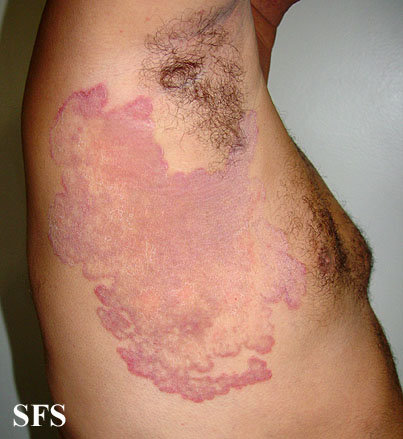 Ringworm is a fungal skin infection caused by Tinea axillaris. It appears as red or brown and scaly rash in the form of circles or rings [3,4]. Risk factors include diabetes mellitus and moist skin.
Ringworm is a fungal skin infection caused by Tinea axillaris. It appears as red or brown and scaly rash in the form of circles or rings [3,4]. Risk factors include diabetes mellitus and moist skin.
Treatment: topical or oral antifungals.
Picture 5. Ringworm (source: Samuel Freire da Silva, M.D., Dermatology Atlas)
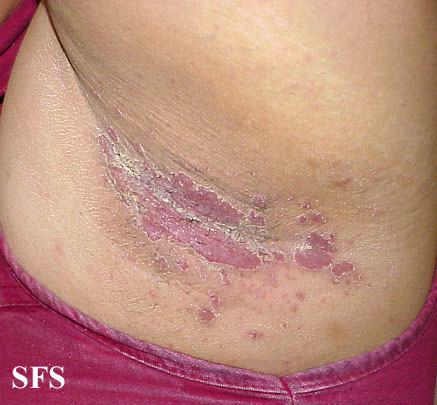 2.2. Cutaneous Candidiasis (Intertrigo)
2.2. Cutaneous Candidiasis (Intertrigo)
Infection with the fungus Candida can cause itchy red, scaly rash in the armpits, groin and other skin folds. Risk factors include moist skin, obesity and decreased immunity due to diabetes, HIV/AIDS, treatment with steroids or antibiotics, chemotherapy [1,2,13,26]. Treatment includes antifungal ointments and powders.
Picture 6. Candida infection (source: Samuel Freire da Silva, MD, Dermatology Atlas)
2.3. Contact Dermatitis
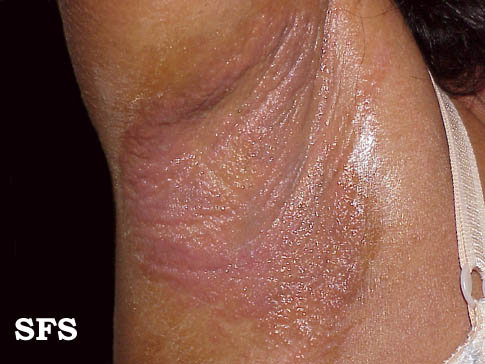 Soaps, deodorants, perfumes, alcohol, topical antibiotics, clothes or dry air can irritate the armpit skin after a single or repeated contact and cause recurring skin inflammation:
Soaps, deodorants, perfumes, alcohol, topical antibiotics, clothes or dry air can irritate the armpit skin after a single or repeated contact and cause recurring skin inflammation:
- Irritant contact dermatitis appears as itchy red, dry, scaly or peeling patches with possible cracks (eczema) in the armpits [10].
- Allergic contact dermatitis appears as itchy pink blisters or patches (hives or urticaria) [1].
Treatment of irritant contact dermatitis can include moisturizing or steroid creams [10]. Treatment of allergic contact dermatitis can include topical or oral steroids or antihistamines, and tacrolimus or pimecrolimus ointments [11,12].
Picture 7. Contact dermatitis (source: Samuel Freire da Silva, M.D., Dermatology Atlas)
2.4. Inverse Psoriasis
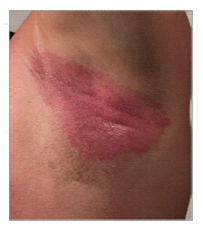 In inverse psoriasis, red plaques with silvery scales that may crack and bleed can appear in the armpits, under the breasts and in the groin [1].
In inverse psoriasis, red plaques with silvery scales that may crack and bleed can appear in the armpits, under the breasts and in the groin [1].
Treatment is with steroid ointments, calcipotriene, coal tar or anthralin [25].
Picture 8. Inverse psoriasis (source: Intechopen, Creative Commons license)
2.5. Erythrasma
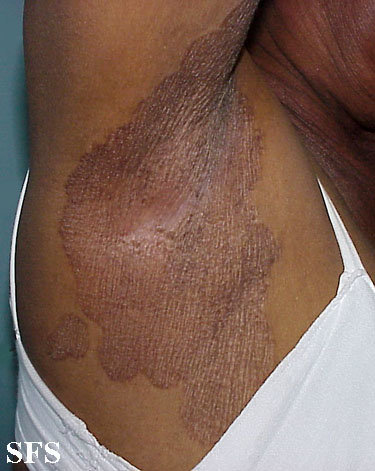 Erythrasma is a chronic skin infection caused by the bacteria Corynebacterium. It appears with sharply outlined red or brown scaly patches in the armpits or groin [20]. The rash is rarely itchy [20]. Risk factors include moist environment, diabetes and obesity.
Erythrasma is a chronic skin infection caused by the bacteria Corynebacterium. It appears with sharply outlined red or brown scaly patches in the armpits or groin [20]. The rash is rarely itchy [20]. Risk factors include moist environment, diabetes and obesity.
Photodynamic therapy can clear or reduce the rash [21].
Picture 9. Erythrasma (source: Samuel Freire da Silva, M.D., Dermatology Atlas)
2.6. Seborrheic Dermatitis
Seborrheic dermatitis appears as scaly skin-colored or red patches on the scalp (dandruff), face, armpits or groin in some people with oily skin. The condition develops due to an increased sensitivity to normal skin yeasts and can be triggered by cold weather and stress [14]. Treatment includes ointments with antifungals and steroids [14].
2.7. Hailey-Hailey Disease
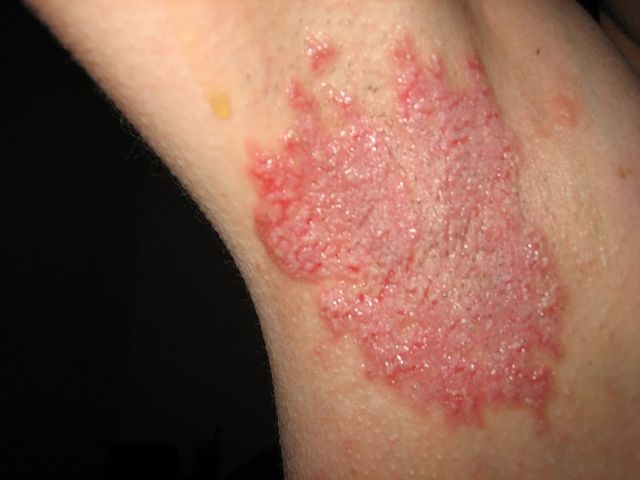 Hailey-Hailey disease or familial benign chronic pemphigus is a hereditary disease with blistering rashes in the armpits or other skin folds, which usually appear in 3rd or 4th decade of life [22].
Hailey-Hailey disease or familial benign chronic pemphigus is a hereditary disease with blistering rashes in the armpits or other skin folds, which usually appear in 3rd or 4th decade of life [22].
Treatment can include topical steroids, antibiotics and benzoyl peroxide [22].
Picture 10. Hailey-Hailey disease (source: Wikipedia, Creative Commons license)
3. Dark Rashes (Hyperpigmentations)
3.1. Acanthosis Nigricans
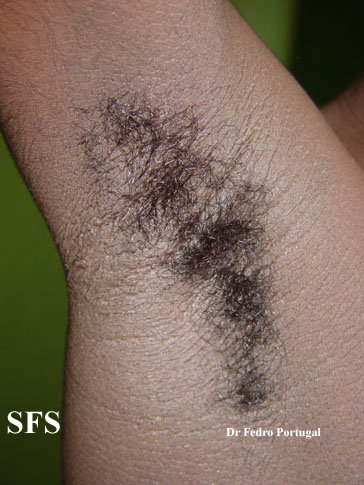 Acanthosis nigricans refers to a thick dark skin on the back of the neck, in the armpits and groin in certain conditions, such as obesity, diabetes mellitus, stomach or other cancer, or as a side effect of drugs (nicotinic acid, insulin, corticosteroids, hormones) [8]. The rash is rarely itchy and can disappear after treatment of the underlying condition.
Acanthosis nigricans refers to a thick dark skin on the back of the neck, in the armpits and groin in certain conditions, such as obesity, diabetes mellitus, stomach or other cancer, or as a side effect of drugs (nicotinic acid, insulin, corticosteroids, hormones) [8]. The rash is rarely itchy and can disappear after treatment of the underlying condition.
Treatment of the rash itself may not be very effective but can include triple-combination depigmenting cream (tretinoin, hydroquinone, fluocinolone acetonide) or oral drugs, such as etretinate and isotretinoin [15].
Picture 11. Acanthosis nigricans (source: Dr. Fedro Portugal, Dermatology Atlas)
4. Skin Tags
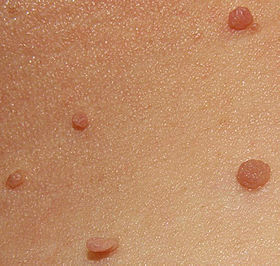 A skin tag (acrochordon) is a piece of skin in the form of “stalk” or “berry” that freely hangs down. Skin tags can be skin-colored or dark brown and are usually painless and harmless. A doctor can tell if there is any danger of development into cancer.
A skin tag (acrochordon) is a piece of skin in the form of “stalk” or “berry” that freely hangs down. Skin tags can be skin-colored or dark brown and are usually painless and harmless. A doctor can tell if there is any danger of development into cancer.
Picture 12. Skin tags (source: Wikipedia, Creative Commons license)
Prevention and Home Remedies
- Wear loose, airy clothes, heat and excessive alcohol drinking to avoid moist in armpits.
- Avoid deodorants, antiperspirants and armpit shaving.
- Do not scratch, if possible, at least not with the nails.
- To reduce itch–only when the skin is not cracked–you can apply [24]:
- Moist cold dressing (for eczema)
- Moist warm dressing (for ingrown hair, folliculitis)
- Baking soda paste
- Calamine lotion (for hives, not for dry skin) [23]
- Colloidal oatmeal (for eczema)
- Menthol/camphor lotion
- Moisturizing creams or emollients (for dry skin eczema)
Frequently Asked Questions
Does HIV/AIDS cause armpit rash?
In HIV/AIDS, rash is a common early symptom; it can appear on the upper chest or back or elsewhere on the skin, including the armpits [27]. Armpit rash is not something what would be specific or typical for HIV, though. The rash that appears only in the armpits is less likely from HIV. Causes of rash in AIDS include the infection itself, other infections and medicines to treat AIDS, such as nevirapine and abacavir.
- References
- Armpit conditions WebMD
- Scheinfeld NS, Cutaneous candidiasis clinical presentation Emedicine
- Bell SA et al, 1996, Tinea axillaris, a variant of intertriginous tinea, due to non-occupational infection with Trichophyton verrucosum PubMed
- Tinea infections MedlinePlus
- Hidradenitis suppurativa signs and symptoms American Academy of Dermatology
- Fox-Fordyce disease DermNet NZ
- Miliaria DermNet NZ
- Ngan V, Acanthosis nigricans DermNet NZ
- Oakly A, Folliculitis barbae and pseudofolliculitis barbae DermNet NZ
- Irritant contact dermatitis DermNet NZ
- Allergic contact dermatitis DermNet NZ
- Hogan DJ, Allergic contact dermatitis Emedicine
- Intertrigo DermNet NZ
- Seborrheic dermatitis DermNet NZ
- Acanthosis nigricans treatment and management Emedicine
- Miliaria DermNet NZ
- Hidradenitis suppurativa, treatment Mayo Clinic
- Topical steroids DermNet NZ
- Bacterial folliculitis DermNet NZ
- Kibbi AG, Erythrasma clinical presentation Emedicine
- Kibbi AG, Erythrasma treatment Emedicine
- Hailey-Hailey disesae DermNet NZ
- Calamine lotion Drugs.com
- Itch, pruritus Dermenet NZ
- Inverse psoriasis National Psoriasis Foundation
- Candidiasis (mucocutaneous) Merck Manual
- HIV and rash AIDSinfo


My armpits are itchy and like white spots patches. What causes them?